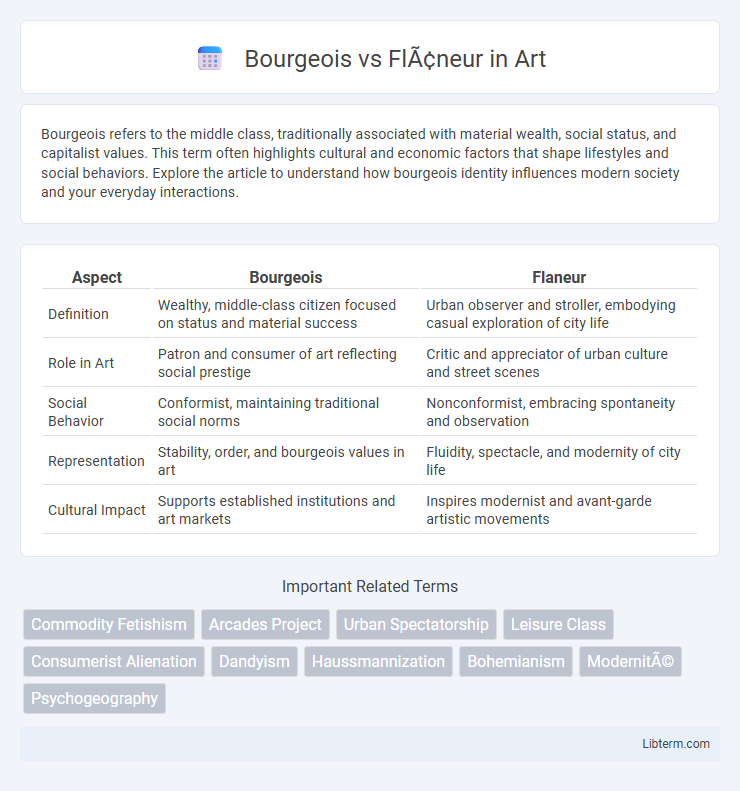Bourgeois refers to the middle class, traditionally associated with material wealth, social status, and capitalist values. This term often highlights cultural and economic factors that shape lifestyles and social behaviors. Explore the article to understand how bourgeois identity influences modern society and your everyday interactions.
Table of Comparison
| Aspect | Bourgeois | Flaneur |
|---|---|---|
| Definition | Wealthy, middle-class citizen focused on status and material success | Urban observer and stroller, embodying casual exploration of city life |
| Role in Art | Patron and consumer of art reflecting social prestige | Critic and appreciator of urban culture and street scenes |
| Social Behavior | Conformist, maintaining traditional social norms | Nonconformist, embracing spontaneity and observation |
| Representation | Stability, order, and bourgeois values in art | Fluidity, spectacle, and modernity of city life |
| Cultural Impact | Supports established institutions and art markets | Inspires modernist and avant-garde artistic movements |
Defining the Bourgeois: Social Identity and Values
The bourgeois represents a social class defined by ownership of capital and a commitment to values such as material success, respectability, and conventional morality. This identity centers on stability, consumerism, and the pursuit of social status within capitalist society. Bourgeois values emphasize work ethic, family orientation, and adherence to established social norms.
The Flâneur: Origins and Characteristics
The Flaneur, originating in 19th-century Paris, embodies the archetype of a detached urban observer who strolls through city streets with a keen eye for detail and social dynamics. This figure contrasts with the Bourgeois by rejecting commercial ambition and embracing leisure, observation, and anonymity within the bustling metropolis. Key characteristics of the Flaneur include a deep curiosity, aesthetic appreciation, and an ability to navigate and interpret urban life as a complex, evolving spectacle.
Historical Context: 19th Century Urban Life
The 19th century urban landscape, marked by rapid industrialization and social transformation, created distinct roles such as the Bourgeois and the Flaneur within emerging city life. The Bourgeois represented the rising middle class focused on commerce, family, and social status, often embodying capitalist values and conservative morality. In contrast, the Flaneur, a figure popularized in Parisian contexts, symbolized leisure, urban exploration, and the critical observer who navigated the bustling streets to experience and reflect on the complexities of modern metropolitan life.
Contrasting Lifestyles: Routine vs Wandering
The bourgeois lifestyle emphasizes routine, stability, and structured social roles, marked by predictable work hours and adherence to societal norms. In contrast, the flaneur embodies a wandering existence, embracing urban exploration, spontaneity, and the leisurely observation of city life. This divergence highlights the bourgeois focus on productivity and order versus the flaneur's pursuit of individual freedom and experiential discovery.
Perspectives on Work and Leisure
The bourgeois views work as a central pillar of identity and social status, emphasizing productivity, discipline, and economic success, while leisure serves as a reward and extension of this capitalist ethic. The flaneur, by contrast, treats leisure as an exploratory and contemplative experience, wandering urban spaces without purpose to observe and reflect on modern life, detaching from traditional work-centered values. This contrast highlights divergent attitudes toward labor, where the bourgeois integrates work and leisure into a structured life, whereas the flaneur prioritizes freedom and sensory engagement over productivity.
Consumer Culture and the City
The Bourgeois embodies consumer culture through active participation in the capitalist marketplace, driving urban economies by valuing material wealth and social status. In contrast, the Flaneur navigates the city as an observer and connoisseur of urban life, detaching from consumerism to experience the city's rhythms and cultural nuances. This dichotomy reflects the tension between commerce-driven urban development and the pursuit of authentic, aesthetic encounters within the modern metropolis.
The Gaze of the Flâneur: Observation vs Participation
The gaze of the flaneur emphasizes detached observation within urban environments, capturing the subtle dynamics and rhythms of city life through a wandering, exploratory perspective. Unlike the bourgeois, who engages with the city as an active participant influenced by social status and consumerist motives, the flaneur occupies a liminal space, blending anonymity with aesthetic curiosity. This distinction highlights the tension between passive spectatorship and social involvement, shaping modern narratives of public space and individual identity.
Bourgeois Morality and Social Conformity
Bourgeois morality emphasizes adherence to social norms and the pursuit of respectability, reflecting middle-class values that prioritize order, discipline, and material success. This morality enforces social conformity by promoting behaviors that align with established economic and cultural standards, often marginalizing individual expression and creativity. The bourgeois individual seeks validation through societal approval, reinforcing a rigid framework of ethical conduct tied to property, family, and status.
The Flâneur in Literature and Art
The flaneur, a quintessential figure in 19th-century literature and art, embodies the detached urban observer who navigates city life with keen perception and aesthetic appreciation. In works by Charles Baudelaire and Walter Benjamin, the flaneur symbolizes modernity's complexity, capturing the decay and vibrancy of the metropolis while critiquing bourgeois values. Artistic representations often highlight the flaneur's role in exploring anonymity, consumer culture, and the blurred boundaries between public and private spaces.
Modern Relevance: Flâneur and Bourgeoisie Today
The flaneur embodies modern urban exploration and cultural observation, often seen in contemporary creatives who navigate cities with a critical, leisurely gaze, contrasting sharply with the bourgeoisie's consumer-driven lifestyle focused on material accumulation and social status. Today's bourgeoisie prioritize economic capital and social distinction through luxury consumption and brand affiliation, while the flaneur values experiential knowledge and subtle social critique inherent in everyday city life. This dichotomy highlights ongoing tensions between passive consumption and active cultural engagement in modern metropolitan environments.
Bourgeois Infographic

 libterm.com
libterm.com